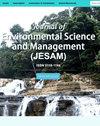Analyzing the Temporal and Spatial Trends of Water Quality and Eutrophication in Laguna de Bay, Philippines, 2000-2012
IF 0.3
4区 环境科学与生态学
Q4 ENVIRONMENTAL SCIENCES
Journal of Environmental Science and Management
Pub Date : 2020-07-16
DOI:10.47125/jesam/2019_sp1/04
引用次数: 1
Abstract
Pollution levels may vary greatly in large waterbodies over long periods of time. Hence, classifying pollution must be inclusive of crucial locations and temporal variabilities. This study applied various statistical techniques to look into the spatial and temporal trends of nine physicochemical parameters within the lake: Biochemical Oxygen Demand (BOD, mg L-1), Ammonia (NH3, mg L-1), Chloride (Cl, mg L-1), Nitrate (NO3, mg L-1), Inorganic Phosphate (PO4, mg L-1), Total Nitrogen (TN, mg L-1), Total Phosphorus (TP, mg L-1), Turbidity (Turb, NTU), and Chlorophyll a (Chl a, μg L-1). Trends were analyzed using data from 2000 to 2012 in five selected stations spread out across the lake. The Trophic State Index (TSI) values of the stations within the study period were also derived from TP, TN, Chl a, and the average of the three parameters. In terms of temporal analysis, general trends, relative monthly values (MV), percent annual changes (PAC) of the nine parameters and their derived TSI values were assessed and analyzed. Spatial trends were assessed by calculating the relative station values (RV) and their standard deviations (SV), principal component analysis (PCA), and hierarchical agglomerated cluster analysis (HACA). BOD and Chl-a have shown statistical growth over the period of 12 years while Cl revealed a consistent decrease in concentration. Moreover, results also showed that Stations 1 and V located at West Bay is the most polluted of all five stations studied, most likely because of its proximity with the highly urbanized and densely populated National Capital Region. This was further supported by HACA results, wherein the two have overwhelmingly similar trends in terms of nutrient and pollutant loadings. Lastly, PCA results revealed that the lake’s current condition can be attributed to BOD, TP, and Chl-a. The generated results comprehensively describe the significant changes in pollution levels within the 13-year period and the relationships between the pollution status of stations located at the lake.2000-2012年菲律宾拉古纳德湾水质与富营养化的时空变化趋势分析
在很长一段时间内,大型水体的污染水平可能变化很大。因此,污染分类必须包括关键地点和时间变化。本研究采用多种统计方法,研究了湖泊内生化需氧量(BOD, mg L-1)、氨(NH3, mg L-1)、氯化物(Cl, mg L-1)、硝酸盐(NO3, mg L-1)、无机磷酸盐(PO4, mg L-1)、总氮(TN, mg L-1)、总磷(TP, mg L-1)、浊度(Turb, NTU)和叶绿素a (Chl a, μ L-1)的时空变化趋势。利用2000年至2012年分布在整个湖上的五个选定站点的数据分析了趋势。利用TP、TN、Chl a和三者的平均值计算了研究期间各站点的营养状态指数(TSI)。在时间分析方面,对9个参数的总体趋势、相对月值(MV)、年变化百分比(PAC)及其衍生的TSI值进行了评价和分析。通过计算相对站值(RV)及其标准差(SV)、主成分分析(PCA)和层次聚集聚类分析(HACA)评估空间趋势。BOD和Chl-a在过去12年中呈统计学增长,而Cl的浓度呈持续下降趋势。此外,结果还显示,位于西湾的1号站和5号站是所有五个研究站点中污染最严重的,很可能是因为它靠近高度城市化和人口稠密的国家首都地区。HACA的结果进一步支持了这一点,其中两者在营养和污染物负荷方面具有压倒性的相似趋势。最后,主成分分析结果表明,湖的现状可归因于BOD、TP和Chl-a。生成的结果全面描述了13年期间污染水平的显著变化以及位于湖泊的站点污染状况之间的关系。
本文章由计算机程序翻译,如有差异,请以英文原文为准。
求助全文
约1分钟内获得全文
求助全文
来源期刊

Journal of Environmental Science and Management
ENVIRONMENTAL SCIENCES-
CiteScore
0.90
自引率
0.00%
发文量
10
审稿时长
2 months
期刊介绍:
The Journal of Environmental Science and Management (JESAM) is an international scientific journal produced semi-annually by the University of the Philippines Los Baños (UPLB).
JESAM gives particular premium to manuscript submissions that employ integrated methods resulting to analyses that provide new insights in environmental science, particularly in the areas of:
environmental planning and management;
protected areas development, planning, and management;
community-based resources management;
environmental chemistry and toxicology;
environmental restoration;
social theory and environment; and
environmental security and management.
 求助内容:
求助内容: 应助结果提醒方式:
应助结果提醒方式:


